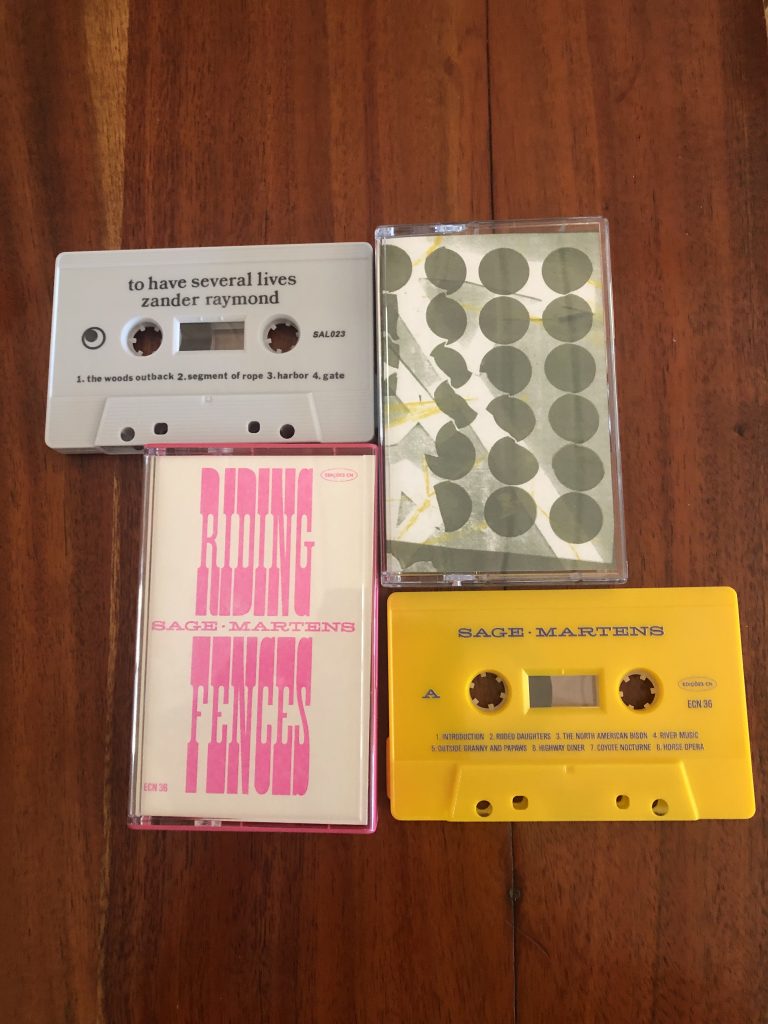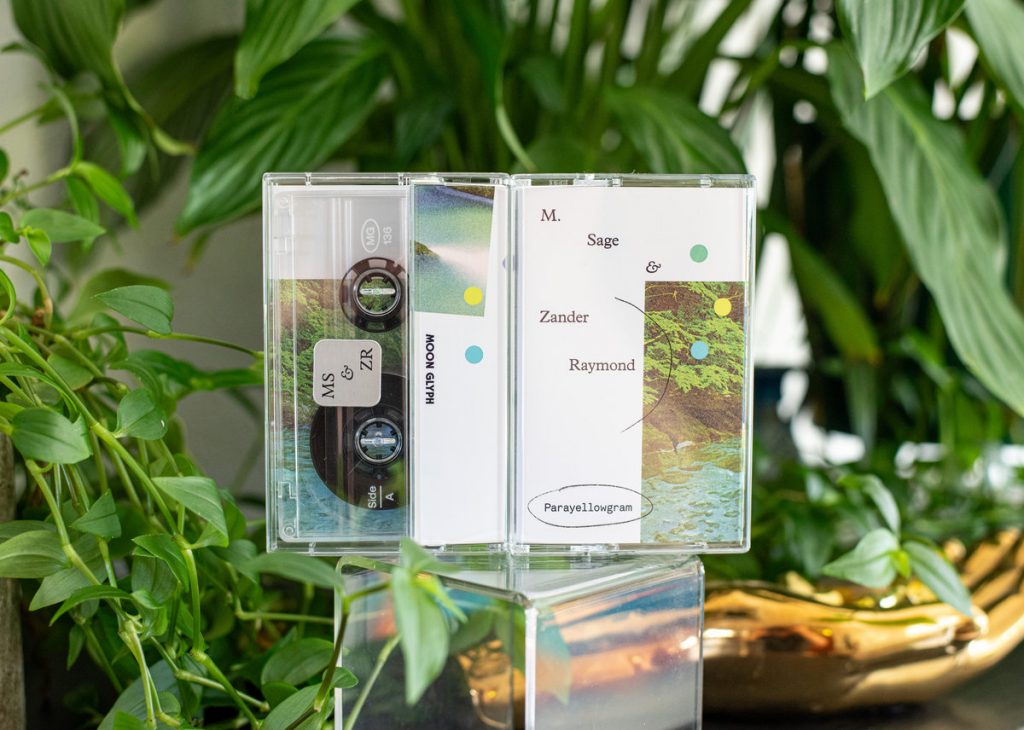M. Sage/Liven Martens – Riding Fences, Zander Raymond – To Have Several Lives, & M. Sage/Z. Raymond – Parayellowgram
9.26.23 by Matty McPherson

When my brother visited last month, he was coming to finally partake in the LA Art Book Festival; such an endeavor required a day off, a token of support as much as a vacation for myself. From my view, the LA Art Book festival happened to be a triumphant celebration of cassette as much as FeelsLikeFloating. If you were on the floor you would have been able to pick up a kinetic variety of radio mixtapes, works from kranky alum Robert Aiki Aubrey Lowe, rare collectables from Masahiro Takahasi, amongst a collection of punk VHS tapes and zines. It sent a shock to my system, a certain realization that the LA Book Art Fair catered to just about any interest, including my own. Alas, there is no zine covering rare titles or connecting the dots on happenings across labels. “There is always a place for your voice to insert itself”, I realized over a bowl of ramen after leaving the event, hopefully destined to one day offer my own print documentation beyond the digital glow.
Meanwhile, noted wiz-kid/tactical event planning guru, Noah Klein, had taken Friday (amongst the weekend) to assemble a smattering of individuals tied to the FeelsLikeFLoating, exemplifying and displaying just how far the series has come in two years. “Cameos appearances” from Dustin Wong and Jordan of Mutual Benefit on the floor grounds were cherries on top, it humbled me to say hello to two individuals of deft compositional prowess. Yet, it was terrific work from Takahasi (a US Live debut if we’re getting the facts right), Diatom Deli, and even M. Sage, who’s role and connections to Klein have traveled over several labels and states. Sage was present early, cooped up at the merch table. He offered ample ear to my conversation while unstuck in time with goods from the past, present, and future of everything he’d slowly worked up to. “Ambient Americana” tropes was on my mind, but I contend that Sage was unstuck in time, having played a long game with a recent string of collaborations and curatorial endeavors. He’d seen the cycles and was just another in a long line of American Mavericks continuing a dialogue that was started decades ago. Only now it was being codified into something that folks like Sage weren’t aiming for, but just happy to keep carving out their own path within. What Sage told me was akin to what the great 18th letter had once emphasized: “Don’t Sweat the Technique”, more or less.
And really why would you sweat the technique? Time hasn’t caught up with Sage, only now it seems to finally understand where he’s been traveling towards. Sage’s 2020s era work has been ever-kinetic. On one side you have Fuubutsushi’s LPs that reveal his potency for digital connection within blissful jazz textures that had been percolating within him. Meanwhile, his LPs for Geographic North and RVNG have seen him skillfully warping the vapor trails and “ghosts” of synthesizer works from before towards a chamber palette akin to Town & Country for hearty celebrations of boating, creek paradises, and the duality of Western living amongst becoming a domestic father. It’s still essentially M. Sage mightily mustering Patient Sounds, but composed to soaring, dizzying heights. “Here’s three and a half minutes of wiggling air. Maybe it’ll tell you a story” is what Sage told me back in 2021, and he’s truly never departed from this open-hearted MO of exploration.
In his collaborative tape from last year with the Belgian Lieven Martens entitled, Riding Fences, Sage perhaps offered his finest entry point to the duality that comes with exploration. That is, where exploration becomes replication of tropes “more truthful than the actual”. Riding Fences’ sense of Western is one teetering on Full Spectrum land art, amongst almost-Hank and Slim desolation from the places Hali Palombo draws out, and with a dash of Steve Roachian Dust to Dust for good measure. The west out here is is comforting as much as it is dissonant, riding on acid logic as the recreation devolves into fogged out mood maps or science experiments. The tape’s titles are like prop directions or movie script locales, kinds that you would find in Monte Hellman films shot in Utah at the bottom of an artificial lake. Except everything has been preserved, waiting for a golden sunrise to light up the floorboard with quantum properties. Low synth drones close to an organ gospel. Piano keys that echo in a barroom. Field recordings & sample that Sage has continued to move to the forefront of the palette. Martens is a crucial partner to the endeavor, himself coming to terms with what it means to explore “western” by way of replication and performance, defusing the exoticism in the process. Nothing to fear, nothing to doubt.
Sage had let it slip that he did have a new collaborative tape, closer to Paradise Crick, coming with Chicago-based Zander Raymond. Raymond had been a cached.media alum all the way back in 2020, but it wasn’t until I was cleaning my tapes that I had properly remembered his debut on Sound as Language from last year. Raymond works with modular synthesizers, focusing around ambient textures that ebb and flow naturally. Last year’s To Have Several Lives, isn’t a series of epiphanies from this process, more or less following in an archtype of “indoor plant life” style pieces that defuse a space or seek to push the attention away from the music, but towards the space. Pieces stretch to five or six minutes, or appear as a flickering neon for just a couple minutes. It makes for aggressively focused room cleaning room as much as a gentle reprieve from the early morning sleepies or rain storm. It also warranted a beat, a collaborator, a direction to tie itself to outside just being well crafted tones. One that arrives on Moon Glyph in the form of Parayellowgram.

Parayellowgram is the kind of platonic cassette release that you’d hope from Sage, Raymond, and Moon Glyph. Its a C40 composed of four 10ish minute pieces, continuing a streak of Moon Glyph erring towards longform adventures and deep zoning on their curation (a wise move giving the label’s releases their own sense of character and liveliness off each other). The two’s pieces haven’t stretched like this outside live performances, and the recordings more or less mend Raymond’s ear for non-linear texture patterns and Sage’s “anything goes” exploration towards a most verdant flavor. The kind closing towards a lost strain of early 00s max/msp-aided post-rock as much as the latest iteration of minimal ambient texture magic between americana and “is that ECM enough for ya?” I wouldn’t be shocked if Sage and/or had been looking back at Claire Rousay’s haptic adventures, which itself is another space that the duo find themselves building off of in ample spades.
“It Is Isn’t It” opens like a mending of one of the two’s own previous works, plenty of keys and bleeping abound! Then halfway through, it finds a bass melody to loop, a jazzy drum pattern to swing to, and a smattering of baritone guitar, robust and saintly. Yellow Against Blue’s underlying drone pegs it close to a misbegotten loop-finding jazz record instrumental, only then using bass and bleeps to build up a sonic cocoon perfect to guide one to dreamed out bliss. Rhythm/Stipple concocts a haptic revolution accelerating skyward with motion, with a particular texture POP near the end that causes a jumping jolt. Closer, John Emerson’s ‘Parayellowgram’, meanwhile steals the entire tape, and gives both performers a display of their collaborative muscle. They work to stage the clattering bustle of a railroad station or even a cattle auction via percussive traps. Yet, Sage and Raymond always finds themselves pushing towards the synths and keys in the mix, glistening and stretching to the blue horizon with a clarinet and strings for good measure.
The beauty to the compositions mark it as one of the year’s most assured ambient excursions full stop, engrossing and giving to the listener. It might be Sage’s best cassette release arguably since Rife With Typo, his original “effort” for RVNG that found solace within Orange Milk. But make no doubt, the lessons of that vaporous age have found themselves transplanted in these compositions today, but Sage and Raymond’s work feels the most timeless both have achieved for the ferric format.
Riding Fences is Sold Out at Edições CN’s bandcamp (but perhaps M. Sage has a tape or two left?), To Have Several Lives is available at Sound as Language’s Bandcamp, and Parayellowgram is available at Moon Glyph’s Bandcamp.
